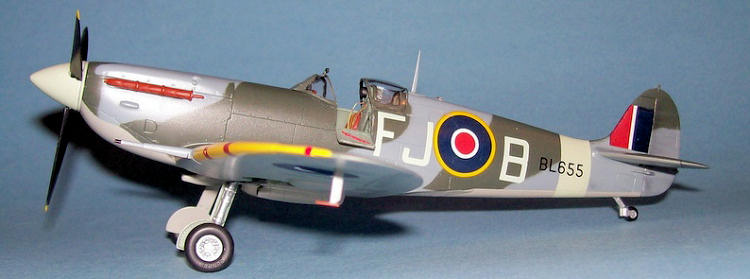
Tamiya 1/48 Spitfire Vb
| KIT #: | 61033 |
| PRICE: | CAD $35.00 |
| DECALS: | Two options |
| REVIEWER: | Pablo Calcaterra |
| NOTES: |
Condor Decals
48011 (Argentines in the RAF), Aeromaster 48-237, Xtradecals X021-48
|

| HISTORY |
 Little was known about the involvement of Argentine volunteers in the RAF, RCAF
and RN until Oscar Raimondi started his research work a few years ago. Claudio
Meunier joined forces, continued and enhanced this project after Raimondi’s
death.
Little was known about the involvement of Argentine volunteers in the RAF, RCAF
and RN until Oscar Raimondi started his research work a few years ago. Claudio
Meunier joined forces, continued and enhanced this project after Raimondi’s
death.
There were almost 1,000 Argentine volunteers that joined the flying forces
during World War II. Most of them were descendants of British people living in
Argentina (i.e. working in the Great Southern Railways) and thus their names
are, no doubt about it, British. But there are many other volunteers that have
Spanish names and yet joined the RAF, RCAF and RN. They flew in every theater of
operations and flew practically all the planes available (from bombers to
fighters to transport to trainers). Some of them remained in
164
Sqn was created on
 During WWII the British community in
During WWII the British community in
The
first Squadron Leader was Tom Rowland and he arrived in Peterhead on April 12th.
There were 18 Spitfires MkVa and a Miles Magister (for communications). The two
next arrivals were the Flight Leaders: Flt Lt Powling (A) and Flt Lt Hopkins
(B),
164
Sqn was declared operational early May 1942. Their badge is a mix of Argentine
and British icons: The Argentine sun (from the Argentine flag) and the British
lion. The motto is FIRMES VOLAMOS (Firmly we fly) and, along with 617 Squadron, it is
one of only two RAF
mottos that are not written either in English or Latin.
Between April and September the Spitfires types allocated were MkVa and b and
included L1013, X4491, R7022, P7309, R6957, W3114, X4421 (called “Olivos” after
the city located in the outskirts of Buenos Aires), R7335, K9825, P9536.
From
September 1942 till February 1943 only MkVb were flown and the list of planes
included EP249, W3426, BM457, W3569, EN904, BL295, E244, BL920, BL655 (“Hurlingham”,
another city close to Buenos Aires and the subject of this article), AB133,
AD121, EP492, AB133, AD191, BL887, BL920, BL368, BL887, AR454, HM133.
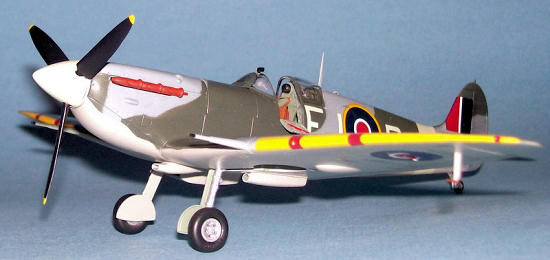 During the “Spitfire times” the Squadron was led by Tom Rowland and was deployed
in the following bases:
During the “Spitfire times” the Squadron was led by Tom Rowland and was deployed
in the following bases:
April-May 1942: Peterhead (
May-September 1942: Skeabrae (
September-October 1942: Peterhead (
October 1942: Tangmere (
October 1942-January 1943: Peterhead (
January-February 1943: Fairwood Common (
While based in Skeabrae the Squadron’s tasks were convoy patrol and protection
of
The
first loss occurred on August 18th when P/O Schaeffer, an Australian,
flew into the water in V4421 during a training exercise with the Army. The next
one and last with Spitfires was the Argentine David Bridger on the 23rd
when he stalled and crashed in Skeabrae during a gunnery exercise.
When
based in Tangmere during October 1942 164 Sqn took part in fighter sweeps and
convoy patrols.
In
February1943 the Squadron moved to
 Now
moving to the subject of this article (BL655) this Spitfire was part of the 3rd
order of 1,000 Spitfires (MkIII) dated
Now
moving to the subject of this article (BL655) this Spitfire was part of the 3rd
order of 1,000 Spitfires (MkIII) dated
1942:
February 4th: TOC 9 MU
and allocated 416 Squadron
April 3rd: Cat Ac
damage when Sgt
April 8th till the 13th:
under repairs on site
July 15th: passed to
602 Sqn
September 11th: Joined
detachment of 164 Sqn (Argentine British), coded FJ*B at Tangmere where it is
thought the naming ceremony (as Hurlingham) took place.
At the center (civilian)
Sir Montague Eddy, President of the
Great Southern Railways. On his right is
Sqn Ldr Tom Rowland. And third from the
right is the Argentine Ronnie Sheward.
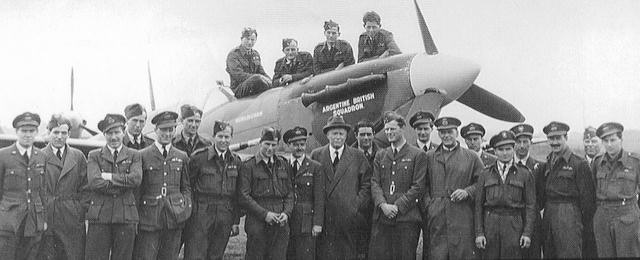
February 3rd:
transferred to 341 Sqn
February 4th: to
Scottish Aviation for repairs
March 13th: awaited
collection
March 30th: sent to 45
MU and Vickers Armstrong for fuel system modifications and wing stiffening
May 8th: to 33 MU and
129 Sqn
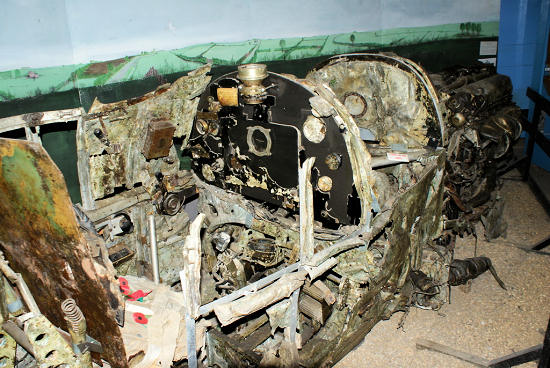 June 11th: back to 416
Sqn
June 11th: back to 416
Sqn
July 1st: Canadian
Flying Officer Norman Alexander Watt killed when BL655 spun out of cloud six
miles east-south-east of Digby and failed to recover.
1989:
Crash sited was excavated.
1990:
Wreckage recovered
1991:
October 19th:
Exhibition opened to the public by Leslie Watt (brother of F/O Norman Watt).
Since then on display at
| THE KIT |
What
a beautiful kit! It is my first Tamiya Spitfire. It has 2 types of windshields
and canopies. It can be built with clipped or standard wings. Decals are for 3
versions including Sailor Malan’s plane (
| CONSTRUCTION |
It
is very straightforward. I painted all interior with Model Master Acryl RAF
Interior Green. Seat was made of Bakelite so a mix of
 red and brown gave an
approximate colour. The instruments panel was painted in black with details
highlighted with a hand of drybrushed silver, some dials in red and drops of
Future for the dials. Seat belt were from Airwaves (AC48-10)
red and brown gave an
approximate colour. The instruments panel was painted in black with details
highlighted with a hand of drybrushed silver, some dials in red and drops of
Future for the dials. Seat belt were from Airwaves (AC48-10)
Everything fits very well and in a couple of days I had the fuselage halves
closed and with a perfect seam.
I
attached the lower portion of the wings to the fuselage and then added the top
halves. Fit was excellent. The wheel wells were painted also in RAF interior
green.
Radiator and oil cooler went with no problem. It can be said about the cannons.
With
a little application of acrylic base paste (cleaned immediately with a damp
cloth) the Spit was ready for painting. The whole process only took a week (hard
to believe when I compare it to my typical projects that involve modifications,
resin parts…)
| COLORS & MARKINGS |
 I
used Model Master Acryl 4759 for the inferior surfaces. Once this was masked
with Tamiya tape and paper I sprayed the darker gray for the fuselage and wings
using Model Master Acryl 4746. For the first time I used a technique I have seen
in some Internet and magazine article: make a copy of the Tamiya color scheme
instructions, cut the areas to be protected (gray), attach them using tape and
make a soft demarcation with worms of Blue tac that were laid over the edge of
the paper masks. Once this was done a coat of Model Master Acryl RAF Dark Green
finished the cammo. It is worth mentioning that it is clear in the picture of
the actual plane that the engine hood came from another plane, as the cammo
lines don’t have the same pattern. I took care of properly painting them, as it
is not reflected in two different color profiles made by artists.
I
used Model Master Acryl 4759 for the inferior surfaces. Once this was masked
with Tamiya tape and paper I sprayed the darker gray for the fuselage and wings
using Model Master Acryl 4746. For the first time I used a technique I have seen
in some Internet and magazine article: make a copy of the Tamiya color scheme
instructions, cut the areas to be protected (gray), attach them using tape and
make a soft demarcation with worms of Blue tac that were laid over the edge of
the paper masks. Once this was done a coat of Model Master Acryl RAF Dark Green
finished the cammo. It is worth mentioning that it is clear in the picture of
the actual plane that the engine hood came from another plane, as the cammo
lines don’t have the same pattern. I took care of properly painting them, as it
is not reflected in two different color profiles made by artists.
The yellow for the wings border of attack was MM Acryl 4721.
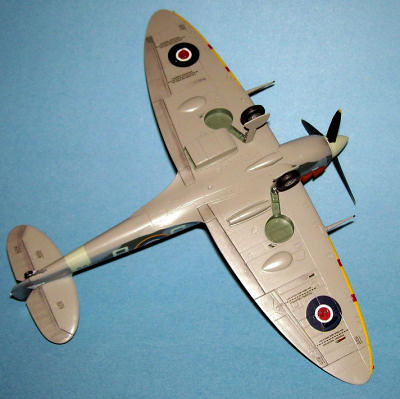 My
usual technique of sanding black pastel and applying it to some areas with a
brush delivered some wear and depth (moveable surfaces, guns). A silver pen
created an effect of chipped paint especially around fasteners and edge of
panels.
My
usual technique of sanding black pastel and applying it to some areas with a
brush delivered some wear and depth (moveable surfaces, guns). A silver pen
created an effect of chipped paint especially around fasteners and edge of
panels.
The
main landing gear was glued in place (minus wheels and doors) as support for the
plane during the process of applying Future.
For the first time I was very patient and applied thin layers of Future allowing them to dry properly before adding the following one. I also started by the bottom, moved to the sides and finished with the top of the plane instead of doing all the plane at the same time. It is one of the very few kits to which I had not to eliminate a running Future. It required more time but it delivered a much better surface to apply the decals to.
All
decals are Tamiya’s except for the specific legends painted on the right side of
the nose (“Hurlingham” and “Argentine British Squadron”) that are from Condor
Decals. Fuselage letters are from Aeromaster and “BL655” came from black serials
from Xtradecals.
More
than a couple of things worth mentioning: I did not like to have to add the
white round decals from Tamiya under the colored roundels.
The fuselage white roundel is slightly smaller than the yellow ring and
therefore if you look closely you will find two tones of yellow. Decals
reacted well to many many hands of Sol. Some wrinkles were not removed
completely and can be
 seen if you look to the model from a very close distance.
I am amazed at the way that Sol worked on the seemingly untreatable decal that
goes over the wing bumps (over the wheels) that read “Not to be walked on” in
red. At first it looked like they would never follow the contour of the bump.
After 5 or 6 layers of Sol it started to soften and the day after the decals
were perfectly following the surface. Magic!
seen if you look to the model from a very close distance.
I am amazed at the way that Sol worked on the seemingly untreatable decal that
goes over the wing bumps (over the wheels) that read “Not to be walked on” in
red. At first it looked like they would never follow the contour of the bump.
After 5 or 6 layers of Sol it started to soften and the day after the decals
were perfectly following the surface. Magic!
Finally it looks like the sky letters on the fuselage were not spaced the same
way on each side, based on the pictures available in Claudio Meunier’s books.
Though not showing BL655, pictures of other Spitfires Vb of the Squadron show an
interesting spacing of the letters on the right side. Therefore I had to cut the
serial numbers on that side to represent the letters painted OVER the serial
numbers as the sky letters seem to be really close to the fuselage band. The
left side of the fuselage is much easy and straightforward.
A
coat of Model Master Acryl semi gloss covered and protected the decals.
| FINAL CONSTRUCTION |
From
this moment on everything went fine and fast: I glued wheels and doors, cap for
the oil tank just ahead of the windscreen, tail wheel, propeller (very nice
attaching system without any rubber ring or glue), gunsight with pad painted in
brown, opened access door.
The
navigation lights (wingtips and tail) were painted. With the silver pencil I
“chipped” some decals to represent wear around some access doors (radio in
fuselage, machine guns).
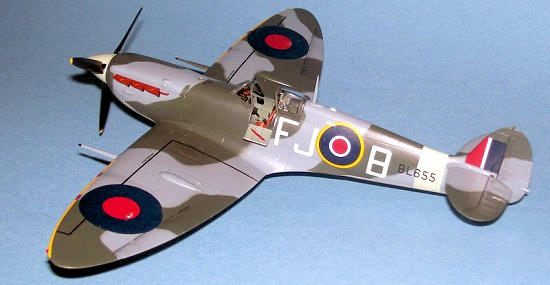 Then
I came to the only frustrating point with this kit: the rear part of the canopy
(the fixed one behind the pilot) would not sit properly. I added instant glue
but it would not stay put, I sanded the voltage regulator for the radio…still
would not sit with the 3 sides touching the fuselage properly. Finally, as it
looked like this part was actually a little bit flattened I tried to get the
sides closed so gain some height…and it cracked on the front left side. D…! In
searched in the spares box and I had none. In the end with more glue and
pressure I got 2 sides sitting and glued properly and a small gap on the left
side that I filled with glue and painted with a brush. Done! The sliding canopy
sits on top of it so somehow covers these not so nice looking details. This
process took me almost 2 hours.
Then
I came to the only frustrating point with this kit: the rear part of the canopy
(the fixed one behind the pilot) would not sit properly. I added instant glue
but it would not stay put, I sanded the voltage regulator for the radio…still
would not sit with the 3 sides touching the fuselage properly. Finally, as it
looked like this part was actually a little bit flattened I tried to get the
sides closed so gain some height…and it cracked on the front left side. D…! In
searched in the spares box and I had none. In the end with more glue and
pressure I got 2 sides sitting and glued properly and a small gap on the left
side that I filled with glue and painted with a brush. Done! The sliding canopy
sits on top of it so somehow covers these not so nice looking details. This
process took me almost 2 hours.
And the last pieces were the windshield, the antenna mast and the rear mirror (painted in black with a drop of aluminum to represent the glass).
| CONCLUSIONS |
Had
it not been for the problem with the rear part of the canopy this would have
been one of my best and easiest kits. There were many valiant Argentines that
flew in support of the Allies in WWII. It is not all about Malvinas (
Stay
tuned for Part II of 164 (Argentine British) Sqn in the coming months.
Claudio Meunier
Andrew Panton (Lincs Aviation Heritage Centre,
| REFERENCES |
Nacidos con Honor (Claudio Meunier)
Lincs Aviation Heritage Centre
http://www.awm.gov.au/catalogue/research_centre/
http://www.veterans.gc.ca/eng/collections/virtualmem/Detail/2358967
http://www.warbirdregistry.org/spitregistry/spitfire-bl655.html
'Gifts of War' by Henry Boot and
Ray Sturtivant
http://www.aircrewremembrancesociety.com/raf1942/bridger.html
January 2012
If you would like your product reviewed fairly and fairly quickly, please contact the editor or see other details in the Note to Contributors.